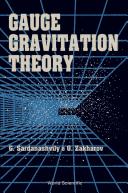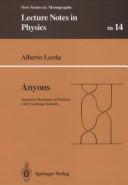| Listing 1 - 6 of 6 |
Sort by
|
Book
ISBN: 9810210280 Year: 1992 Publisher: Singapore World scientific
Abstract | Keywords | Export | Availability | Bookmark
 Loading...
Loading...Choose an application
- Reference Manager
- EndNote
- RefWorks (Direct export to RefWorks)
Gauge fields (Physics) --- Congresses --- Veltman, Martinus.

ISBN: 9810206607 9810206593 Year: 1992 Publisher: Singapore World Scientific
Abstract | Keywords | Export | Availability | Bookmark
 Loading...
Loading...Choose an application
- Reference Manager
- EndNote
- RefWorks (Direct export to RefWorks)
Elementary particles --- Quarks. --- Leptons (Nuclear physics) --- Gauge fields (Physics) --- Quarks --- Leptons (Physique nucléaire) --- Champs de jauge (Physique) --- Leptons (Physique nucléaire)

ISBN: 9814360082 9789814360081 9810207999 9789810207991 Year: 1992 Publisher: Singapore River Edge, NJ World Scientific
Abstract | Keywords | Export | Availability | Bookmark
 Loading...
Loading...Choose an application
- Reference Manager
- EndNote
- RefWorks (Direct export to RefWorks)
This concise monograph is intended for students and scientists specializing in contemporary field theory, gravitation theory and modern differential geometry. The gauge theory as presented by the authors, incorporates Einstein's gravity into the universal picture of fundamental interactions and clarifies its physical nature as a Higgs field. A key point advanced here is the spontaneous breakdown of space-time symmetries according to the equivalence principle. The jet manifold generalization of the fibre bundle machinery is used to describe this symmetry breaking, degenerate Hamiltonian systems and general connections.
Gauge fields (Physics) --- Gravitation. --- Field theory (Physics) --- Matter --- Physics --- Antigravity --- Centrifugal force --- Relativity (Physics) --- Fields, Gauge (Physics) --- Gage fields (Physics) --- Gauge theories (Physics) --- Group theory --- Symmetry (Physics) --- Properties

ISBN: 069108775X 9780691037691 0691037698 9780691087757 Year: 1992 Publisher: Princeton Princeton university press
Abstract | Keywords | Export | Availability | Bookmark
 Loading...
Loading...Choose an application
- Reference Manager
- EndNote
- RefWorks (Direct export to RefWorks)
This book is a systematic study of the classical and quantum theories of gauge systems. It starts with Dirac's analysis showing that gauge theories are constrained Hamiltonian systems. The classical foundations of BRST theory are then laid out with a review of the necessary concepts from homological algebra. Reducible gauge systems are discussed, and the relationship between BRST cohomology and gauge invariance is carefully explained. The authors then proceed to the canonical quantization of gauge systems, first without ghosts (reduced phase space quantization, Dirac method) and second in the BRST context (quantum BRST cohomology). The path integral is discussed next. The analysis covers indefinite metric systems, operator insertions, and Ward identities. The antifield formalism is also studied and its equivalence with canonical methods is derived. The examples of electromagnetism and abelian 2-form gauge fields are treated in detail.The book gives a general and unified treatment of the subject in a self-contained manner. Exercises are provided at the end of each chapter, and pedagogical examples are covered in the text.
Gauge fields (Physics) --- Quantum theory --- Champs de jauge (Physique) --- Théorie quantique --- 530.19 --- Quantum dynamics --- Quantum mechanics --- Quantum physics --- Physics --- Mechanics --- Thermodynamics --- Fields, Gauge (Physics) --- Gage fields (Physics) --- Gauge theories (Physics) --- Field theory (Physics) --- Group theory --- Symmetry (Physics) --- Fundamental functions in general. Potential. Gradient. Intensity. Capacity etc. --- Quantum theory. --- Gauge fields (Physics). --- 530.19 Fundamental functions in general. Potential. Gradient. Intensity. Capacity etc. --- Théorie quantique --- Fundamental functions in general. Potential. Gradient. Intensity. Capacity etc

ISBN: 3540561056 0387561056 3540474668 9783540561057 9780387561059 Year: 1992 Volume: 14 Publisher: Berlin : ©1992 Springer-Verlag,
Abstract | Keywords | Export | Availability | Bookmark
 Loading...
Loading...Choose an application
- Reference Manager
- EndNote
- RefWorks (Direct export to RefWorks)
Gauge fields (Physics) --- Anyons --- -Statistical methods --- 536.75 --- -Gauge fields (Physics) --- Quantum statistics --- 530.19 --- Quantum statistical mechanics --- Matrix mechanics --- Statistical mechanics --- Wave mechanics --- Fields, Gauge (Physics) --- Gage fields (Physics) --- Gauge theories (Physics) --- Field theory (Physics) --- Group theory --- Symmetry (Physics) --- Particles (Nuclear physics) --- Entropy. Statistical thermodynamics. Irreversible processes --- Statistical methods --- Fundamental functions in general. Potential. Gradient. Intensity. Capacity etc. --- 530.19 Fundamental functions in general. Potential. Gradient. Intensity. Capacity etc. --- 536.75 Entropy. Statistical thermodynamics. Irreversible processes --- Fundamental functions in general. Potential. Gradient. Intensity. Capacity etc --- Particules (physique nucléaire) --- Champs de jauge (physique) --- Statistique quantique. --- Quantum statistics. --- Méthodes statistiques --- Statistical methods. --- Anyons - - Statistical methods --- -Anyons --- Particules (physique nucléaire) --- Méthodes statistiques
Book
ISBN: 0691213860 Year: 1992 Publisher: Princeton, New Jersey : Princeton University Press,
Abstract | Keywords | Export | Availability | Bookmark
 Loading...
Loading...Choose an application
- Reference Manager
- EndNote
- RefWorks (Direct export to RefWorks)
This book is a systematic study of the classical and quantum theories of gauge systems. It starts with Dirac's analysis showing that gauge theories are constrained Hamiltonian systems. The classical foundations of BRST theory are then laid out with a review of the necessary concepts from homological algebra. Reducible gauge systems are discussed, and the relationship between BRST cohomology and gauge invariance is carefully explained. The authors then proceed to the canonical quantization of gauge systems, first without ghosts (reduced phase space quantization, Dirac method) and second in the BRST context (quantum BRST cohomology). The path integral is discussed next. The analysis covers indefinite metric systems, operator insertions, and Ward identities. The antifield formalism is also studied and its equivalence with canonical methods is derived. The examples of electromagnetism and abelian 2-form gauge fields are treated in detail. The book gives a general and unified treatment of the subject in a self-contained manner. Exercises are provided at the end of each chapter, and pedagogical examples are covered in the text.
Gauge fields (Physics) --- Abelian constraints. --- Berezin integral. --- Canonical Hamiltonian. --- Fourier transformation. --- Gauss law. --- Gaussian average. --- Green functions. --- Heisenberg algebra. --- Jacobi identity. --- Kunneth formula. --- Lagrange multipliers. --- Pauli matrices. --- antighost number. --- auxiliary fields. --- boundary operator. --- cohomology. --- convolution. --- derivations. --- differential. --- doublet. --- effective action. --- extended action. --- exterior product. --- harmonic states. --- involution. --- left derivatives. --- local commutativity. --- nontrivial cycle. --- superdomain.
| Listing 1 - 6 of 6 |
Sort by
|

 Search
Search Feedback
Feedback About UniCat
About UniCat  Help
Help News
News